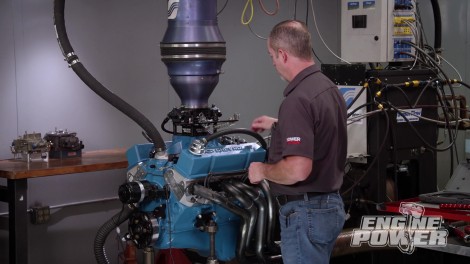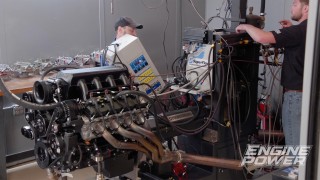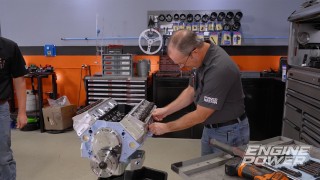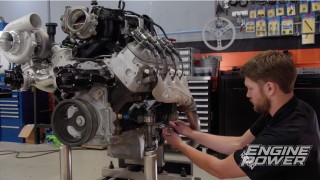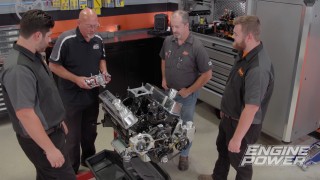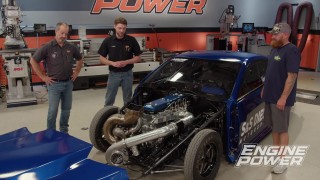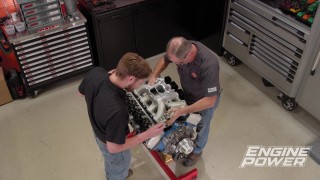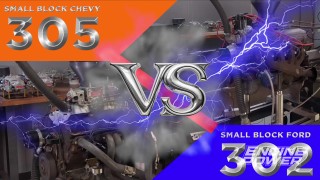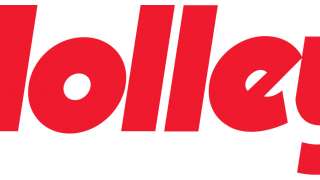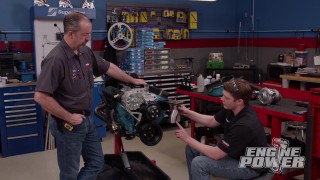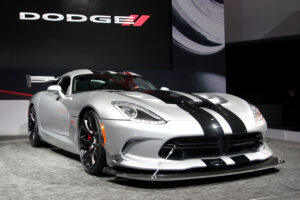Engine Power Featured Projects
Engine Power Builds
Want more content like this?
Join the PowerNation Email NewsletterVideo Transcript
(Pat)>> You're watching Powernatoin!
(Pat)>> If you're serious about your high performance engine there are two things you'll always do.
(Frankie)>> One is testing and tuning it to perfection, and the other is performing the maintenance needed to keep it running long and strong. [ Music ]
(Frankie)>> Welcome to Engine Power where we are back in our favorite place, our dyno cell. That's because we're gonna continue thrashing on our 360 cubic inch small block Chevy affectionately named Compression Obsession. Last time we picked up a bunch of power and this is where we ended up. We kept the existing rotating assembly but swapped in a custom grind solid roller cam shaft with more duration and lift. Duration at 50 thousandths lift is 252 degrees on the intake and 260 degrees on the exhaust. Lobe separation angle is 110 degrees. Lift at the valve is 653 thousandths on the intake and 660 thousandths on the exhaust. We degreed the cam setting the intake centerline at 105.5 degrees. We used a Jesel valvetrain setup along with Comp Endure-X solid roller lifters. Running the AFR 220 Eliminator heads we have a measured static compression ratio of 13.36 to 1. After reinstalling a Summit Racing harmonic balancer, we added an MSD seven inch flying magnet crank trigger assembly. This will give us incredibly accurate ignition timing, which is very beneficial at higher r-p-m.
(Pat)>> The Jesel rockers are 1.5 to 1 ratio, and they are torqued to 26 pound feet. An Edelbrock Super Victor intake manifold came next, followed by an MSD crank trigger distributor. We wanted to see how this engine would run on E-85. We used racing E-85 to ensure consistent ethanol level in the fuel. For fuel metering we chose the QFT 850 c-f-m E-85 drag race carburetor, which we got from Holley. It's designed to handle the higher fuel flow of the ethanol. With 35 degrees of total timing the small block 567 horsepower and 477-pound feet of torque. That's almost 100 horsepower more than our previous gasoline based run. We experimented with several spacers and got the best result from the two-inch tall four hole tapered spacer yielding 576 horsepower and 485 pound feet of torque. Now that was a lot of fun but we still have plenty to do. We're gonna continue tuning on this current fuel to see what it will do, and then we're gonna change it up with some different fuel to see if we can make some more power. Also, we're gonna show you some cool tech that helps keep your race engine together. So, without further ado let's get to it.
(Frankie)>> Can't get after it too much. We're still on a stock cast crank.
(Pat)>> Shhh! Alright, with any new dyno session we have to establish a new baseline. We have a different day, the air correction is different. More importantly the air is different as far as inlet temperature and humidity. So, we're gonna reestablish a baseline to see where we're at. Four to seven!
(Frankie)>> Here we go, baseline! [ engine revving ]
(Pat)>> What a nice engine. That's good, 567, I'll take that, 476. A tad bit lower but that's okay.
(Frankie)>> Just looking at the air/fuel ratio it's a little bit leaner, which is a factor of the different air and stuff. Yeah, it made a little bit less but I think we could definitely pick that back up and maybe go a little bit more.
(Pat)>> When vacuum goes up it means there's no detonation. If you have pan vacuum and it goes up, up, up, and then it comes back down then the engine's starting to go into detonation.
(Frankie)>> Then you have cylinder pressure escaping into the pan.
(Pat)>> This is one of the rare things we do when we're actually adding fuel instead of taking it away.
(Frankie)>> To do that we'll pull the float bowls and increase the primary and secondary jets by six sizes, giving us 99s in the front and 107s in the back. This seems like a large increase but alcohol fuel requires much larger changes because of the additional fuel flow.
(Pat)>> We'll see what it does. The proof is in the dyno numbers.
(Frankie)>> Here we go! [ engine revving ]
(Pat)>> We'll see a little result there. Okay so it picked up, 568.6, which that's good, and it picked up a little bit of torque, 482.
(Frankie)>> All the way through there it picked up a little bit, which is nice. I think we can go a little bit more and be safe.
(Pat)>> We'll see if we can put some more to it.
(Frankie)>> We'll repeat the process adding three more jet sizes for 102s in the front and 110s in the rear. Let's see what she does. [ engine revving ]
(Pat)>> Well it didn't drop power.
(Frankie)>> I don't know if it made any more.
(Pat)>> It made a tad bit more. We're almost back to where we were on the other with the different air conditions. So, we're at 569.8. We're gonna call that 570.
(Frankie)>> And 482.9-pound feet. There's a little bit of pick up here in the middle torque range but the rest of the way it almost looks the same. The only thing we could do is up in the upper r-p-m range the b-s-f-c is starting to go up. So, it's starting to richen up a little bit. We can put some air bleed in it.
(Pat)>> Let's go four thousandths on the air bleed and see what that does. We've got to pull the air horn.
(Frankie)>> That's not that hard. We'll stuff a shop towel into the venturis to ensure that the air bleeds can't accidentally fall into the carburetor. We're swapping out the 31 thousandths air bleeds that this carb came with for a set of 35s in the high speed circuit. [ Music ]
[ Music ] Alright, going from a 31 high speed air bleed to a 35.
(Pat)>> Hopefully that affects the top end of the pull and cleans it up a little bit. We're hunting for power here.
(Frankie)>> Little rooms for improvement, that's all. Only one way to find out, right? Here we go! [ engine revving ]
(Pat)>> Well might have snuck a couple in her.
(Frankie)>> 572, okay!
(Pat)>> So basically, we're tuning for conditions. The dyno corrects so you can compare apples to apples. The tune-up obviously is effective. It's too lean it's not gonna make as much.
(Frankie)>> The air will still affect that but that's the gain right there. So that's the change we just did.
(Pat)>> See what happens, and it starts picking up right after 5,500.
(Frankie)>> A little bit but it's there, and you can correlate that to the b-s-f-c's cause they're just a little bit lower.
(Frankie)>> What you thinking? You want to do some more fuel stuff or you want to move on?
(Pat)>> I think we should move on. I think there's something that we want to show that we haven't shown in a long time, or haven't shown as much as we should have, and it's the magic lash loops.
(Frankie)>> Heck yeah, let's do it! Up next, running lash loops on your engine can tell you a lot about how it's running, and help you pick up a little extra power.
(Frankie)>> Like we said, we're gonna try some lash loops on this engine, but we wanted to take a second to explain what that actually means. When you run lash loops you increase and decrease the amount of lash the engine has, and it effectively changes the duration of the cam shaft. It's something that's very specific for each application. So, you just have to try it and see what happens.
(Pat)>> For instance, if you increase the lash and the engine picks up chances are the cam may be a little bit for the application, but if you decrease the lash and the engine picks up chances are you may need a bigger cam shaft. Since this is a dyno mule this is a great place to try something. [ Music ] [ engine cranking ]
(Frankie)>> The first thing we're gonna try is increasing the lash five thousandths. This effectively shrinks the cam lobe's profile slightly in both duration and lift. [ Music ]
(Pat)>> Alright, what's your guess?
(Frankie)>> For power?
(Pat)>> Yeah, is it gonna pick it up?
(Frankie)>> I don't think so but you never know. That's why we do this. I don't think so but we wouldn't know unless we tried it. Coolant temp back where it's supposed to be and everything should be good.
(Pat)>> Give her a rip.
(Frankie)>> See what happens. [ engine revving ]
(Pat)>> I think it dropped a little bit of power. That's what it should do.
(Frankie)>> That's what you would see if you put a smaller cam in. That makes a lot of sense. If you were gonna put a smaller cam in apparently that's what you would see. That's not a bad thing. It's something you try and something you find out. So now we'll go the other way, tighten it up, and see what it does there.
(Pat)>> And just to clarify this, you can only increase lash on a lobe usually about 5 thousandths before you start getting into trouble. You can decrease lash. You can tighten the lash up as much as it won't start when it's cold. It's easier, safer to tighten the lash. [ Music ] Now we'll decrease the lash from our original setting by five thousandths. That's a 10 thousandths swing in valve lash. So, this is sort of an abbreviated test because normally you'd just pick one. You do the intake or the exhaust. We're doing them together, but it's going to show the general of why we do lash lobe.
(Frankie)>> And it kinda shows the effect of it. We increase the lash and we lost power. So hopefully now that we swung the other way. We swung 10 thousandths of lash. It should at least restore the power that we lost. Hopefully maybe pick up a little bit from where we started.
(Frankie)>> Ready? Here we go! [ engine revving ]
(Frankie)>> I think I saw something there.
(Pat)>> It might be okay.
(Frankie)>> Oh snap, 577.9 horsepower and 482.9-pound feet. So that's a definite improvement.
(Pat)>> It's a little improvement. If you overlay...
(Frankie)>> Here's before we did any lash adjustment at all. So down low trading back and forth. Above 6,000, I would say, definitely has a noticeable increase.
(Pat)>> So if you look at that and say, could this use a bigger cam for that operating range, I think you could probably put a few more degrees in it and it would be okay.
(Frankie)>> And it's good because you can look at that and say okay, so if I did go a few more degrees you wouldn't lose anything down low but you would definitely benefit up top. I think that's cool that we can show that. It's something simple that you can do but something that you can actually see the gains from.
(Pat)>> To do this and actually see a gain or see a loss you're gonna need the dyno.
(Frankie)>> That's why we're doing this. So, everybody else can know that this is something you can try. It depends on the engine to see the result, but this definitely picked up.
(Pat)>> Look how far it swung power from when it had...
(Frankie)>> And we can show that. This is our 10 degrees of lash from excess lash to us decreasing the lash. That's a huge difference.
(Pat)>> It's like 12 horse up top or something. What is it at 7,000?
(Frankie)>> It's like 13 horse at 7,000.
(Pat)>> Just from a few thousandths of lash adjustments. I love engines! We've been having a lot of fun with E-85, but we want to see what our engine can do on 104 octane race gas.
(Pat)>> We have been having lots of fun and learning some stuff running E-85 on our current setup. It's been letting us get after the tune, and this thing is making some great power, but that begs the question. What would happen if we ran this engine on real racing gasoline. Well, we are about to find out. We are gonna switch out our 850, which is an E-85 specific 850 from QFT, to old reliable, which is our dyno carburetor, our QFT Black Diamond 950. Now this one is a little bit bigger. 950 versus 850, but it's not as much about the carburetor as about what the fuel will do. All we have to do is get the fuel in the cell changed out. I already have this most of the way unhooked. We'll get old reliable on and make a hit. [ Music ] Our fuel is 104 octane unleaded racing fuel. It's oxygenated and has a stoichiometric ratio of 13.34 to 1, which means even though it's much more expensive it will use less fuel. Alright, same sweep, same r-p-m range. We have switched out the E-85 carburetor for our gasoline one. Let's make a hit and see what happens. [ engine revving ]
(Pat)>> I can tell you what it did do. It made more power, 591, 489-pound feet. That is a significant gain over the E-85, but it tells you something. The E-85 wasn't exactly that bad. The E-85 was almost as good as the expensive race fuel. Now we're talking race fuel now that's $20 dollars a gallon versus E-85, which is not $20 a gallon. That is pretty impressive. Can we improve on that? I'm not sure. We could probably give it a try and maybe rub on it some more. You did the same thing that you would do with this setup that you would with the E-85 you'd be further ahead because that's why you're trying things. Engines react differently to different fuels. The big part of this one is the fuel was better. Race gas is designed to be better. E-85 is a good alternative if you don't have race gas available. You can get after the tune-up almost as much and make almost as much power as race gas. It was a great test. Up next, to keep your engine healthy sometimes it needs a thorough examination.
(Pat)>> We just finished up a successful dyno session testing somethings and learning on our compression obsession 360 small block Chevrolet. Now we're gonna take the opportunity to see how well the engine is living, both from a cylinder ceiling standpoint and a valvetrain standpoint, and we have a few specialty tools on the table to make that happen. For the cylinders I'll show you how to check them a couple of different ways. Both with a leak down gauge and a cranking compression gauge. The leak down gauge pressurizes the cylinder and shows the differential on a gauge of how much cylinder leakage it will have. The cranking compression gauge screws into the spark plug hole, and you turn the engine over with the starter, and it generates a pressure on the gauge to show how much pressure the cylinder is generating. Now obviously we're doing this after our dyno session, but this is standard procedure to do after a race car comes off the track. If you have bad leak down or not enough cranking compression like you had before chances are you've hurt the engine and got to tear it back down. For the valvetrain we are gonna re-check our torque on our adjustors and we're gonna re-check our lash. We know what our cold lash setting was versus our hot. So that's easy to find out if something's moving around. For the valve springs we'll re-check the seat pressure of the spring with our portable tool here. We set the heads up on the bench so we know how much spring pressure they head initially. So, we will check to see how they're living. These are both great indicators on how well the engine is handling the abuse you are giving it. If things aren't doing what they should and they're not holding up chances are you have to look at your combination and make a few adjustments. Obviously, we'll check every cylinder, but we'll start on the number one at t-d-c of its compression stroke. Checking leak down allows you to verify the seal on the valves and the rings. We used 100 p-s-i as our base pressure. A reading of under 10 percent is an indicator of a well sealed cylinder. After that is completed, we'll do a cranking compression test on each cylinder. With a gauge hooked up we'll turn the engine over with the starter until the needle stops going up. The value will be different engine but generally numbers over 160 p-s-i indicate a healthy engine. You should always check this before running the engine so you'll have a reference point. We'll go through and check our cold lash to verify that it hasn't changed. Too much lash indicates premature wear, and not enough lash could indicate valve tuliping. [ Music ] The torque is checked on all of the adjustor nuts. Even if you are not adjusting the lash it's a good thing to double check. [ Music ] This cool tool from LSM allows us to check valve spring seat pressures on the engine. A drop from the original set spring pressure can indicate that the springs are nearing the end of their service life. [ Music ] Another crucial part of preventative maintenance is cutting apart and inspecting the oil filter. A high quality oil filter cutter like this one from Goodson makes the job go smoothly. If there's any debris the material type will tell you what's wearing inside the engine. For instance, gold or aluminum flakes would indicate premature bearing wear. We'll cut the filter element out with a razor so it comes out cleanly and is easier to inspect. [ Music ] Now this filter is super clean, and that's a good indication that nothing is going on that's bad. We do this on every engine that we dyno, whether you see us to it or not. That's standard procedure on anything that you're gonna dyno or anything that you race. When the filter's clean you know the engine's doing well. The tech we've done today here is universal. It'll work on your daily driver, your weekend warrior, or even your full tilt race engine, and I must say that our stock cast crank 360 has done everything that we have asked of it. In the future we're gonna ask it to do more, but until then I'm gonna get this engine unhooked and then I'm gonna go try and find Frankie because he's taking a little bit too much time chasing parts. He's probably out getting some ice cream, or petting zoo. I don't know what kids do nowadays.
(Frankie)>> If you want to see more cool tech like this go check out Powernation!
Show Full Transcript
(Pat)>> If you're serious about your high performance engine there are two things you'll always do.
(Frankie)>> One is testing and tuning it to perfection, and the other is performing the maintenance needed to keep it running long and strong. [ Music ]
(Frankie)>> Welcome to Engine Power where we are back in our favorite place, our dyno cell. That's because we're gonna continue thrashing on our 360 cubic inch small block Chevy affectionately named Compression Obsession. Last time we picked up a bunch of power and this is where we ended up. We kept the existing rotating assembly but swapped in a custom grind solid roller cam shaft with more duration and lift. Duration at 50 thousandths lift is 252 degrees on the intake and 260 degrees on the exhaust. Lobe separation angle is 110 degrees. Lift at the valve is 653 thousandths on the intake and 660 thousandths on the exhaust. We degreed the cam setting the intake centerline at 105.5 degrees. We used a Jesel valvetrain setup along with Comp Endure-X solid roller lifters. Running the AFR 220 Eliminator heads we have a measured static compression ratio of 13.36 to 1. After reinstalling a Summit Racing harmonic balancer, we added an MSD seven inch flying magnet crank trigger assembly. This will give us incredibly accurate ignition timing, which is very beneficial at higher r-p-m.
(Pat)>> The Jesel rockers are 1.5 to 1 ratio, and they are torqued to 26 pound feet. An Edelbrock Super Victor intake manifold came next, followed by an MSD crank trigger distributor. We wanted to see how this engine would run on E-85. We used racing E-85 to ensure consistent ethanol level in the fuel. For fuel metering we chose the QFT 850 c-f-m E-85 drag race carburetor, which we got from Holley. It's designed to handle the higher fuel flow of the ethanol. With 35 degrees of total timing the small block 567 horsepower and 477-pound feet of torque. That's almost 100 horsepower more than our previous gasoline based run. We experimented with several spacers and got the best result from the two-inch tall four hole tapered spacer yielding 576 horsepower and 485 pound feet of torque. Now that was a lot of fun but we still have plenty to do. We're gonna continue tuning on this current fuel to see what it will do, and then we're gonna change it up with some different fuel to see if we can make some more power. Also, we're gonna show you some cool tech that helps keep your race engine together. So, without further ado let's get to it.
(Frankie)>> Can't get after it too much. We're still on a stock cast crank.
(Pat)>> Shhh! Alright, with any new dyno session we have to establish a new baseline. We have a different day, the air correction is different. More importantly the air is different as far as inlet temperature and humidity. So, we're gonna reestablish a baseline to see where we're at. Four to seven!
(Frankie)>> Here we go, baseline! [ engine revving ]
(Pat)>> What a nice engine. That's good, 567, I'll take that, 476. A tad bit lower but that's okay.
(Frankie)>> Just looking at the air/fuel ratio it's a little bit leaner, which is a factor of the different air and stuff. Yeah, it made a little bit less but I think we could definitely pick that back up and maybe go a little bit more.
(Pat)>> When vacuum goes up it means there's no detonation. If you have pan vacuum and it goes up, up, up, and then it comes back down then the engine's starting to go into detonation.
(Frankie)>> Then you have cylinder pressure escaping into the pan.
(Pat)>> This is one of the rare things we do when we're actually adding fuel instead of taking it away.
(Frankie)>> To do that we'll pull the float bowls and increase the primary and secondary jets by six sizes, giving us 99s in the front and 107s in the back. This seems like a large increase but alcohol fuel requires much larger changes because of the additional fuel flow.
(Pat)>> We'll see what it does. The proof is in the dyno numbers.
(Frankie)>> Here we go! [ engine revving ]
(Pat)>> We'll see a little result there. Okay so it picked up, 568.6, which that's good, and it picked up a little bit of torque, 482.
(Frankie)>> All the way through there it picked up a little bit, which is nice. I think we can go a little bit more and be safe.
(Pat)>> We'll see if we can put some more to it.
(Frankie)>> We'll repeat the process adding three more jet sizes for 102s in the front and 110s in the rear. Let's see what she does. [ engine revving ]
(Pat)>> Well it didn't drop power.
(Frankie)>> I don't know if it made any more.
(Pat)>> It made a tad bit more. We're almost back to where we were on the other with the different air conditions. So, we're at 569.8. We're gonna call that 570.
(Frankie)>> And 482.9-pound feet. There's a little bit of pick up here in the middle torque range but the rest of the way it almost looks the same. The only thing we could do is up in the upper r-p-m range the b-s-f-c is starting to go up. So, it's starting to richen up a little bit. We can put some air bleed in it.
(Pat)>> Let's go four thousandths on the air bleed and see what that does. We've got to pull the air horn.
(Frankie)>> That's not that hard. We'll stuff a shop towel into the venturis to ensure that the air bleeds can't accidentally fall into the carburetor. We're swapping out the 31 thousandths air bleeds that this carb came with for a set of 35s in the high speed circuit. [ Music ]
[ Music ] Alright, going from a 31 high speed air bleed to a 35.
(Pat)>> Hopefully that affects the top end of the pull and cleans it up a little bit. We're hunting for power here.
(Frankie)>> Little rooms for improvement, that's all. Only one way to find out, right? Here we go! [ engine revving ]
(Pat)>> Well might have snuck a couple in her.
(Frankie)>> 572, okay!
(Pat)>> So basically, we're tuning for conditions. The dyno corrects so you can compare apples to apples. The tune-up obviously is effective. It's too lean it's not gonna make as much.
(Frankie)>> The air will still affect that but that's the gain right there. So that's the change we just did.
(Pat)>> See what happens, and it starts picking up right after 5,500.
(Frankie)>> A little bit but it's there, and you can correlate that to the b-s-f-c's cause they're just a little bit lower.
(Frankie)>> What you thinking? You want to do some more fuel stuff or you want to move on?
(Pat)>> I think we should move on. I think there's something that we want to show that we haven't shown in a long time, or haven't shown as much as we should have, and it's the magic lash loops.
(Frankie)>> Heck yeah, let's do it! Up next, running lash loops on your engine can tell you a lot about how it's running, and help you pick up a little extra power.
(Frankie)>> Like we said, we're gonna try some lash loops on this engine, but we wanted to take a second to explain what that actually means. When you run lash loops you increase and decrease the amount of lash the engine has, and it effectively changes the duration of the cam shaft. It's something that's very specific for each application. So, you just have to try it and see what happens.
(Pat)>> For instance, if you increase the lash and the engine picks up chances are the cam may be a little bit for the application, but if you decrease the lash and the engine picks up chances are you may need a bigger cam shaft. Since this is a dyno mule this is a great place to try something. [ Music ] [ engine cranking ]
(Frankie)>> The first thing we're gonna try is increasing the lash five thousandths. This effectively shrinks the cam lobe's profile slightly in both duration and lift. [ Music ]
(Pat)>> Alright, what's your guess?
(Frankie)>> For power?
(Pat)>> Yeah, is it gonna pick it up?
(Frankie)>> I don't think so but you never know. That's why we do this. I don't think so but we wouldn't know unless we tried it. Coolant temp back where it's supposed to be and everything should be good.
(Pat)>> Give her a rip.
(Frankie)>> See what happens. [ engine revving ]
(Pat)>> I think it dropped a little bit of power. That's what it should do.
(Frankie)>> That's what you would see if you put a smaller cam in. That makes a lot of sense. If you were gonna put a smaller cam in apparently that's what you would see. That's not a bad thing. It's something you try and something you find out. So now we'll go the other way, tighten it up, and see what it does there.
(Pat)>> And just to clarify this, you can only increase lash on a lobe usually about 5 thousandths before you start getting into trouble. You can decrease lash. You can tighten the lash up as much as it won't start when it's cold. It's easier, safer to tighten the lash. [ Music ] Now we'll decrease the lash from our original setting by five thousandths. That's a 10 thousandths swing in valve lash. So, this is sort of an abbreviated test because normally you'd just pick one. You do the intake or the exhaust. We're doing them together, but it's going to show the general of why we do lash lobe.
(Frankie)>> And it kinda shows the effect of it. We increase the lash and we lost power. So hopefully now that we swung the other way. We swung 10 thousandths of lash. It should at least restore the power that we lost. Hopefully maybe pick up a little bit from where we started.
(Frankie)>> Ready? Here we go! [ engine revving ]
(Frankie)>> I think I saw something there.
(Pat)>> It might be okay.
(Frankie)>> Oh snap, 577.9 horsepower and 482.9-pound feet. So that's a definite improvement.
(Pat)>> It's a little improvement. If you overlay...
(Frankie)>> Here's before we did any lash adjustment at all. So down low trading back and forth. Above 6,000, I would say, definitely has a noticeable increase.
(Pat)>> So if you look at that and say, could this use a bigger cam for that operating range, I think you could probably put a few more degrees in it and it would be okay.
(Frankie)>> And it's good because you can look at that and say okay, so if I did go a few more degrees you wouldn't lose anything down low but you would definitely benefit up top. I think that's cool that we can show that. It's something simple that you can do but something that you can actually see the gains from.
(Pat)>> To do this and actually see a gain or see a loss you're gonna need the dyno.
(Frankie)>> That's why we're doing this. So, everybody else can know that this is something you can try. It depends on the engine to see the result, but this definitely picked up.
(Pat)>> Look how far it swung power from when it had...
(Frankie)>> And we can show that. This is our 10 degrees of lash from excess lash to us decreasing the lash. That's a huge difference.
(Pat)>> It's like 12 horse up top or something. What is it at 7,000?
(Frankie)>> It's like 13 horse at 7,000.
(Pat)>> Just from a few thousandths of lash adjustments. I love engines! We've been having a lot of fun with E-85, but we want to see what our engine can do on 104 octane race gas.
(Pat)>> We have been having lots of fun and learning some stuff running E-85 on our current setup. It's been letting us get after the tune, and this thing is making some great power, but that begs the question. What would happen if we ran this engine on real racing gasoline. Well, we are about to find out. We are gonna switch out our 850, which is an E-85 specific 850 from QFT, to old reliable, which is our dyno carburetor, our QFT Black Diamond 950. Now this one is a little bit bigger. 950 versus 850, but it's not as much about the carburetor as about what the fuel will do. All we have to do is get the fuel in the cell changed out. I already have this most of the way unhooked. We'll get old reliable on and make a hit. [ Music ] Our fuel is 104 octane unleaded racing fuel. It's oxygenated and has a stoichiometric ratio of 13.34 to 1, which means even though it's much more expensive it will use less fuel. Alright, same sweep, same r-p-m range. We have switched out the E-85 carburetor for our gasoline one. Let's make a hit and see what happens. [ engine revving ]
(Pat)>> I can tell you what it did do. It made more power, 591, 489-pound feet. That is a significant gain over the E-85, but it tells you something. The E-85 wasn't exactly that bad. The E-85 was almost as good as the expensive race fuel. Now we're talking race fuel now that's $20 dollars a gallon versus E-85, which is not $20 a gallon. That is pretty impressive. Can we improve on that? I'm not sure. We could probably give it a try and maybe rub on it some more. You did the same thing that you would do with this setup that you would with the E-85 you'd be further ahead because that's why you're trying things. Engines react differently to different fuels. The big part of this one is the fuel was better. Race gas is designed to be better. E-85 is a good alternative if you don't have race gas available. You can get after the tune-up almost as much and make almost as much power as race gas. It was a great test. Up next, to keep your engine healthy sometimes it needs a thorough examination.
(Pat)>> We just finished up a successful dyno session testing somethings and learning on our compression obsession 360 small block Chevrolet. Now we're gonna take the opportunity to see how well the engine is living, both from a cylinder ceiling standpoint and a valvetrain standpoint, and we have a few specialty tools on the table to make that happen. For the cylinders I'll show you how to check them a couple of different ways. Both with a leak down gauge and a cranking compression gauge. The leak down gauge pressurizes the cylinder and shows the differential on a gauge of how much cylinder leakage it will have. The cranking compression gauge screws into the spark plug hole, and you turn the engine over with the starter, and it generates a pressure on the gauge to show how much pressure the cylinder is generating. Now obviously we're doing this after our dyno session, but this is standard procedure to do after a race car comes off the track. If you have bad leak down or not enough cranking compression like you had before chances are you've hurt the engine and got to tear it back down. For the valvetrain we are gonna re-check our torque on our adjustors and we're gonna re-check our lash. We know what our cold lash setting was versus our hot. So that's easy to find out if something's moving around. For the valve springs we'll re-check the seat pressure of the spring with our portable tool here. We set the heads up on the bench so we know how much spring pressure they head initially. So, we will check to see how they're living. These are both great indicators on how well the engine is handling the abuse you are giving it. If things aren't doing what they should and they're not holding up chances are you have to look at your combination and make a few adjustments. Obviously, we'll check every cylinder, but we'll start on the number one at t-d-c of its compression stroke. Checking leak down allows you to verify the seal on the valves and the rings. We used 100 p-s-i as our base pressure. A reading of under 10 percent is an indicator of a well sealed cylinder. After that is completed, we'll do a cranking compression test on each cylinder. With a gauge hooked up we'll turn the engine over with the starter until the needle stops going up. The value will be different engine but generally numbers over 160 p-s-i indicate a healthy engine. You should always check this before running the engine so you'll have a reference point. We'll go through and check our cold lash to verify that it hasn't changed. Too much lash indicates premature wear, and not enough lash could indicate valve tuliping. [ Music ] The torque is checked on all of the adjustor nuts. Even if you are not adjusting the lash it's a good thing to double check. [ Music ] This cool tool from LSM allows us to check valve spring seat pressures on the engine. A drop from the original set spring pressure can indicate that the springs are nearing the end of their service life. [ Music ] Another crucial part of preventative maintenance is cutting apart and inspecting the oil filter. A high quality oil filter cutter like this one from Goodson makes the job go smoothly. If there's any debris the material type will tell you what's wearing inside the engine. For instance, gold or aluminum flakes would indicate premature bearing wear. We'll cut the filter element out with a razor so it comes out cleanly and is easier to inspect. [ Music ] Now this filter is super clean, and that's a good indication that nothing is going on that's bad. We do this on every engine that we dyno, whether you see us to it or not. That's standard procedure on anything that you're gonna dyno or anything that you race. When the filter's clean you know the engine's doing well. The tech we've done today here is universal. It'll work on your daily driver, your weekend warrior, or even your full tilt race engine, and I must say that our stock cast crank 360 has done everything that we have asked of it. In the future we're gonna ask it to do more, but until then I'm gonna get this engine unhooked and then I'm gonna go try and find Frankie because he's taking a little bit too much time chasing parts. He's probably out getting some ice cream, or petting zoo. I don't know what kids do nowadays.
(Frankie)>> If you want to see more cool tech like this go check out Powernation!
